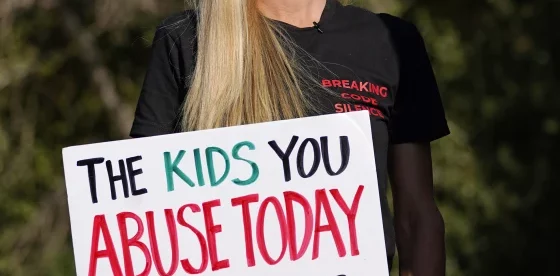I See You, Survivor: A Call to Dismantle the Troubled Teen Industry

(Source)
The “Troubled Teen” Industry is composed of various Congregate Care Facilities or Congregate Care Programs (CCFs/CCPs) that claim to provide housing and treatment for teens displaying “troubled” behaviors such as addiction, eating disorders, low self-esteem, general disobedience, and at times even targeting sexual orientation and gender identity. These facilities are often privately run by various companies, nonprofits as well as faith-based organizations. There are anywhere from 120,000–200,000 teens estimated to be currently enrolled in these CCF/CCPs. Despite the deceptively benign intentions behind the programs, the experiences of the youth forced into these programs are often anything but pleasant.
These programs often limit and manipulate communication between parents and their children, inflicting a form of punishment known as “Code Silence.” This punishment isolates the child not only from contacting their loved ones at home but also isolates them from others residing at the program by not allowing them to speak. The Breaking Code Silence movement is meant to counter the indoctrinated command to remain silent and urges victims to speak out. Social media has long been used as a means of political activism, so it was no surprise when victims of the “Troubled Teen” Industry took to the social media platform Tiktok to validate and acknowledge the experiences of fellow survivors. Using the hashtag #BreakingCodeSilence – spearheaded by the survivor-led organization of the same name– activists spoke out in order to raise awareness of the often unspoken trauma faced by American youth forced into these programs. With frequent instances of physical and sexual abuse, starvation, lack of hygiene and proper healthcare, physical restraints, forced conversion therapy, heavily limited contact with the outside world, and even death, this movement is long overdue.
CCF/CCP facilities have existed for decades and have run with little to no government regulation. In fact, the roots of these questionable facilities can be traced back to the 1960s anti-drug rehabilitation center turned cult Synanon, a program designed to break the wills of heroin addicts in order to “cure” their addictions. The cult was known to use methods such as public humiliation, isolation, sleep deprivation, and manual labor. A significant number of existing CCF/CCPs can be seen working under the same treatment philosophy of “tough love,” breaking the spirits of teenagers so as to modify their behavior into something less “troubling.” Common practices involve kidnapping teens in the middle of the night into the remote wilderness with little more than the clothes on their backs, using tactics such as “food deprivation, sleep deprivation, public humiliation, beatings, and denial of access to the bathroom to the point where you wet or soil yourself.” The U.S. Government Accountability Office (GAO) published an investigative report in which they identified “thousands of allegations of abuse, some of which resulted in death, at residential programs across the country.” The report found that the abuse that did occur was systemic in nature within the programs, and “ineffective management and operating practices, in addition to untrained staff, contributed to the death and abuse of youth enrolled in selected programs.” There have been nearly 200 recorded deaths at CCFs/CCPs across the country since 1971. Desperation without Dignity — a report published by the National Disability Rights Network (NDRN)— discovered that physical abuse, overuse and misuse of psychiatric medication, inadequate access to clean water, and frequent application of restraints/seclusion were exceedingly present in a number of for-profit residential programs.
Even in the face of this abuse, these operations still remain entirely legal with little to no government regulation. The reason lies in parents’ consent- “a critical aspect of the whole operation is gaining parental permission through an affidavit or power of attorney agreement.” By temporarily transferring parental rights to the CCF/CCPs, program workers are given great power over teens to the point that they can authorize medical “treatments” or restrain them without question. These programs evade federal regulations through a simple loophole, by avoiding identifying themselves as “mental health facilities.” As if to add insult to injury, parents pay thousands of dollars to unknowingly expose their child to institutional abuse: one such program regularly receives an annual revenue of over $200 million. As a whole, the “Troubled Teen” industry receives an estimated $23 billion dollars of annual public funds.
The Troubled Teen Industry has run practically untouched for decades, and it cannot be allowed to do so any longer. Federal attempts have been made to regulate the industry in the past, but have been unsuccessful for over a decade. The Stop Child Abuse in Residential Programs for Teens Act of 2017 was introduced but expired without any votes. Any regulation for these CCF/CCPs that does exist has only been state-specific. For example, Utah Governor Spencer Cox signed a law designed to apply stronger regulations to the state’s more than 100 residential youth programs. It was revealed that the law is filled with loopholes, however, that still allows the unlimited use of restraints, use of drugs, and isolation rooms with the caveat that use of these methods is reported to the government. Few other states have attempted to pass legislation to regulate the troubled teen industries, but enforcement is state-specific and doesn’t appear to be particularly effective. Socialite and reality TV star Paris Hilton has been the public face of the movement, speaking out and organizing protests due to her own traumatizing experience with the troubled teen industry. Hilton highlighted the main issues at hand- “it’s clear that the state-by-state patchwork of limited, weak oversight and inconsistent licensing requirements is not working.” The NDRN’s Desperation without Dignity Report mirrored these sentiments– “a ‘first this, then that’ approach has resulted in a cyclical non-solution, with a great deal of planning and very little change.”
After the rush of activism spurred on by Breaking Code Silence and Hilton, hope may be on the horizon. Congress has announced that they are drafting the Accountability for Congregate Care Act, legislation designed to establish a bill of rights for youth in CCF/CCPs as well as create national standards that these programs must meet or be forced to shut down. The Act would also require data collection and set aside federal funding for states to implement the new measures. While this is incredibly promising, it is already incredibly difficult to pass a bill in Congress. After previous attempts at federal legislation failed nearly every year for the last ten years, it is important to recognize the bill may not become reality for a long while, if at all. In the meantime, there will be countless instances of abuse and trauma continually inflicted upon youth throughout the country. Without any stringent and uniform enforcement in place, the corruption of the troubled teen industry cannot be allowed to go on.
In an ideal world, the system would first be dismantled at its roots and reformed from scratch- with the parameters mandated and upheld by federal legislation like the Accountability for Congregate Care Act. More realistically, states should follow suit in creating their own rigid enforcement mechanisms. For example, in 2019 Montana shifted oversight of state CCFs/CCPs from an industry-dominated board to the Montana Department of Public Health and Human Services. By the end of 2020, 11 of Montana’s 19 programs had closed in part due to the new regulations at play. It is important to mention there are still loopholes in this legislation, however. For example, Montana’s law does not regulate religious programs. Alternatively, California’s comprehensive attempt to protect the legal and human rights of a person receiving services from a community care facility resulted in the California Community Care Facilities Act. California Governor Gavin Newsom also recently passed a law that banned the sending of any children to privately-run out-of-state facilities after numerous victims reported physical and sexual abuse by employees. Instead, California counties are being provided with $139 million to develop in-state, locally based programs. In addition to heightened regulations, direct oversight by government offices, and state funding for local programs, beneficial change can also be achieved through amending existing legislation as well. The Child Abuse Prevention and Treatment Act (CAPTA) provides federal funding to states for the prevention and treatment of child abuse. By amending CAPTA to specifically address institutional child abuse, states would have greater resources as well as incentives to prevent and regulate illegitimate residential treatment programs. This industry has the potential to help teens instead of traumatizing them, so it is high time we took the steps necessary to protect these children and provide them the opportunity to genuinely heal.

About the Author: Nicole Belenitsky is a second-year student at Cornell Law School. Nicole graduated from the Macaulay Honors College at Baruch College where she studied Political Science as well as Communication Studies with a focus on rhetoric and public advocacy. She is the Senior Online Editor for Cornell Law School’s Journal of Law and Public Policy’s The Issue Spotter. She currently serves as the Social Chair for If/When//How: Lawyering for Reproductive Justice as well as Social Chair for the Jewish Law Students Association.
Suggested Citation: Nicole Belenitsky, I See You, Survivor: A Call to Dismantle the Troubled Teen Industry, Cornell J.L. & Pub. Pol’y, The Issue Spotter, (March 31, 2022), http://jlpp.org/blogzine/i-see-you-survivor-a-call-to-dismantle-the-troubled-teen-industry/.
